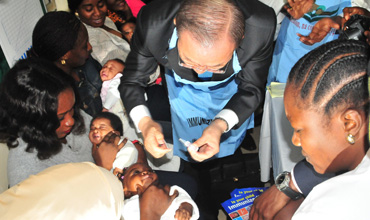Effect of Socio-demographic Characteristics on Healthcare Seeking Behaviour among Users of Primary Health Care Facility in Ado-Odo Ota Local Government Area, Ogun State, Nigeria

Abstract:
Introduction: Healthcare seeking behaviour has been defined as any set
of actions undertaken by an individual who perceives a health problem or an
illness for the purpose of finding an appropriate remedy1. This is
based on an Explanatory model which has a coherent picture of specific cultural
features and these features in turn predispose an individual to certain health
behaviour. Against the backdrop of the need for understanding the effects of
socio-demographiccharacteristics on
healthcare seeking behaviour of individuals from sociological
perspectives, this study assessed some of those factors among users of primary
health care facility (PHC)in Ado-Odo Ota local government (LGA), Ogun State,
Nigeria.
Methods:
Descriptive cross sectional study among 300 selected users of PHC that are
resident of Ado-Odo Ota using multistage sampling method. Data was analyzed
using the SPSS software version 21.0. Three
hundred (male-97, female 203) users of PHC were sampled through multistage sampling technique in these wards.
Instrument used for data collection was a self-developed, validated
questionnaire with reliability of 0.72 using Chrombach alpha coefficient.
Multiple regression, Analysis of Variance and Independent T-test were used to
test the hypotheses at 0.05 level of significance.
Results:
Using the framework from the
‘‘four As’ theories and concepts; findings based on the survey revealed that
household headship, educational level
and income predicted increase in
service utilization at PHC in Ado-Odo Ota LGA (R = .252; R2 =
.064; Adj. R2 = .054) ;(F calculated (3, 299) = 6.715
> f-table = 3.86; p <.05). Statistical significance also existed in
service utilization between male and female in the study area.
Conclusion:
Based
on the study outcome, it was recommended among others that there
is need for continuous community mobilization by healthcare providers
especially the Public/Community health Nurses and Community extension workers
to enhance active community involvement and continuous increase in service
utilization.
Keywords: Healthcare seeking, PHC Users, Ogun
State, Nigeria.
References:
[1]. Ado-Odo/Ota
Local Government. Ogun State Ministry of Local Govt. and Chieftancy
Affairs. www.ikimap.com Retrieved 3
October,2015.
[2]. Akande
T.M.,Owoyemi J.O. Health Seeking Behaviour in Ayingba, North-Central Nigeria.
Research Journal of Medical Sciences 2(4):185-189 2009.
[3]. Buor,
D. Analysing the primacy of distance in
the utilization of health services in the Ahafo-Ano South district, Ghana. International
Journal of Health Planning & Management., 18(4), 293-311. 2003.
[4]. Caldwell JC,
Caldwell P. What have we learnt about the cultural, social and behavioural determinants of health? From
Selected Readings to the first Health
Transition Workshop. Health Transit Rev 1991; 1: 3-19.
[5]. Craig P,
Forbes J. Social position and health: are old and new occupational classifications interchangeable? J Biosoc
Sci 2005; 37:89-106.
[6]. Foster, G.M.
and Anderson, B.G. Medical Anthropology. John Wiley and sons Inc. USA.
Kleinman, A. Patients and Healers in the context of culture. Berkeley:
University of California press, 1980.
[7]. Foreit, J.,
& Foreit, K. The reliability and
validity of willingness to pay surveys for reproductive health pricing
decisions in developing countries. Health Policy, 63(1), 37-47. 2003.
[8]. Gotsadze,
G., Bennet, S., Ranson, K., & Gzirishvili, D. Health care-seeking behaviour and
out-of-pocket payments in Tbilisi, Georgia. Health Policy and Planning, 20(4),
232-242. 2005.
[9]. Hausmann
Muela, S. Community understanding the malaria, and treatment seeking behaviour
in a hole-endemic area of south-eastern Tanzania. Ph.D Thesis Swiss Tropical
Institute, University of Basel, Switzerland. 2012.
[10]. HERFON;
Proceedings of National Health Conference. Theme: ‘’Primary Health Carein
Nigeria: Thirty years after Alma Ata. Abuja, Nigeria.
[11]. Institute
of Development Studies. Mobilizing social science research to improve health.
IDS Policy Briefing. Issue 23. Sussex. 2005.
[12]. MacKian S.
A review of health seeking behaviour: problems and prospects. Internal concept
paper. Health Systems Development Programme, London School of Hygiene and
Tropical Medicine. London. 2001.
[13]. Musah K.T & Kayode O.O. Preliminary Assessment of Healthcare
Seeking Behaviour Among Users of Primary Health Care Facilities in Ilorin
Metropolis, Kwara State, Nigeria. IOSR Journal of Nursing and Health
Science (IOSR-JNHS) Volume 3, Issue 4 Ver. I (Jul-Aug. 2014), PP 31-35 www.iosrjournals.org
[14]. Musah K.T.,
Okeya E.O., Kayode O.O., Abuh A., & Obinna R. Effects of Socio-demographic Characteristics
on Health Care Seeking Behaviour among Residents of Ilaje Local Government
Area, Ondo State, Nigeria. A paper
presented at the International Conference on Health & Wellbeing; Bristol,
United Kingdom. June 22-26, 2013.
[15]. Nyamongo,
I. K. Health care seeking behaviour of
malaria patients in a Nigerian rural community. Social Science &
Medicine, 54(3), 377-386. 2002.
[16].
Onwujekwe
O. Inequities in healthcare seeking in the treatment of communicable endemic
diseases in Southeast Nigeria. Soc Sci Med. 2005 Jul;61(2):455-63.
[17]. Post
Offices- with map of LGA . NIPOST. Archived from the original on 7 October
2009. www.ikimap.com Retrieved 3 October,2015.
[18]. Ryan, G.W.
What do sequential behaviour patterns suggest about medical decision making
process? Modelling home case management of acute illness in a rural Cameroonian
village. Social Sci. Med. 2005; 46:209-225.
[19]. World
Health Organization. Jakarta Declaration on Leading Health Promotion into the
21st Century. The Fourth International Conference on Health Promotion: New
Players for a New Era- Leading Health Promotion into the 21st Century. Jakarta.
1997.
[20]. World
Health Organization. Mexico Ministerial Statement for the Promotion of Health.
The Fifth Global Conference on Health Promotion. Health Promotion: Bridging the
Equity Gap. Mexico City. 2000.

